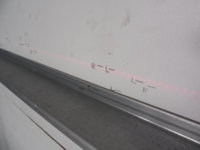The newer Okuma machines aren't too bad on the alarms, and with the control just being a computer the manual is a button away. Plus they are extremely easy to program. Biggest area you have to watch is clearance between the turret and sub spindle. No alarm, set it wrong and they'll meet.
-
Enjoy XS650.com? Consider making a donation to help support the site.
XS650.com receives a small share of sales from some links on this page, but direct donations have a much greater impact on keeping this site going.
You are using an out of date browser. It may not display this or other websites correctly.
You should upgrade or use an alternative browser.
You should upgrade or use an alternative browser.
Is it my turn? Anything to do with lathes, mills and other shop tools
set it wrong and they'll meet
 ....which sounds noisy and expensive.
....which sounds noisy and expensive. 

 ....and will result in the boss.....
....and will result in the boss..... ....followed by....
....followed by....
I'll play along. Bought a '40s era 10x24 Montgomery Wards/Logan lathe about 5yrs ago to make a couple wheel spacers for a project at that time, the first step on a slippery slope. Sold that & got the Logan 11x24 now in use.
Got a lathe guess I should have a mill to go with it. Enter an Index645 9x40 vertical mill. Metal shaper - what's that? - better have one of those! Logan 8", early '50s machine.
Almost forgot the 12x24 Clausing "project" lathe in the midst of a teardown/clean-up/repaint.
no wonder I can't seem to get any work done on the 650 build or other projects going on! may have to seek professional help one of these days, if I can stay off Craigslist long enough.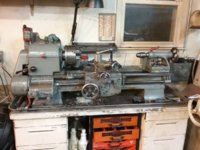
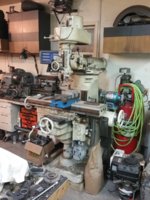
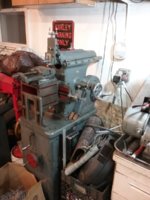
Got a lathe guess I should have a mill to go with it. Enter an Index645 9x40 vertical mill. Metal shaper - what's that? - better have one of those! Logan 8", early '50s machine.
Almost forgot the 12x24 Clausing "project" lathe in the midst of a teardown/clean-up/repaint.
no wonder I can't seem to get any work done on the 650 build or other projects going on! may have to seek professional help one of these days, if I can stay off Craigslist long enough.



^^^Ooooooooo, I'm officially jealous! NICE shop!
Jeez Gary, you making parts for a Martian lander with that thing? 
Wow Beags64 - I haven’t seen a shaper in a loooong time! Nice collection in a very capable shop.
Pete
Pete
^^^Ooooooooo, I'm officially jealous! NICE shop!
Hi Downeaster,
the Grammar Police say that you ain't jealous at all; what you are is envious, just like me.
Mebbe 40 years ago our machine shop got it's very first programmable machining center so I wandered over to check it out.
There it was, working away all by itself with sheets of coolant everywhere making it hard to see what was going on behind the safety windows.
Gerry my friendly machinist came over to say,
"Yeah, the kid programmed the part into the machine's computer, pushed the start button and then goofed off some place.
Pity he set the first cut too deep so the cutter bust off when it touched down.
The machine don't know the cutter broke and it's been machining nothing for the last hour."
Yup - I’ve seen that happen too Fred. What a shame.
Fred: I stand (well, sit actually...) corrected. Envious indeed.
Got some tooling in today and got to play with my mini-lathe. I'm pretty impressed. Won't be taking any big hogging cuts with it, but hey, I'm retired. Time, I got.
Got some tooling in today and got to play with my mini-lathe. I'm pretty impressed. Won't be taking any big hogging cuts with it, but hey, I'm retired. Time, I got.
[QUOTE="Downeaster, post: 532640, member: 7479"Got some tooling in today Time, I got.[/QUOTE]
Well take your time and go get some "action pics" what'd yah get????
Well take your time and go get some "action pics" what'd yah get????
Pretty sure I posted a picture of the lathe, but just in case:

Didn't take any pictures of the playing but made a couple of bearing spacers out of Schedule 40 pipe and turned a piece of steel rod down to fit a dial indicator stand I had laying around. Using el cheapo Amazon tooling from Anytime Tools. 1/4 inch holders with indexable carbide inserts. Makes a pretty cut as long as you don't try to take a lot at once.
Got a set of center drills from the same outfit, tried them out by drilling a hole in the center of a bolt. Poifeck. That's gonna make cross-drilling pins for zerks a snap. Been doing it by guess and good luck on a drill press.
The lathe was in good shape right out of the box, just cleaned it up good and lubed it. Runout on the chuck was just a hair over .001, tool post and chuck centers matched up in good shape, no slop in the crossfeed or compound.

Didn't take any pictures of the playing but made a couple of bearing spacers out of Schedule 40 pipe and turned a piece of steel rod down to fit a dial indicator stand I had laying around. Using el cheapo Amazon tooling from Anytime Tools. 1/4 inch holders with indexable carbide inserts. Makes a pretty cut as long as you don't try to take a lot at once.
Got a set of center drills from the same outfit, tried them out by drilling a hole in the center of a bolt. Poifeck. That's gonna make cross-drilling pins for zerks a snap. Been doing it by guess and good luck on a drill press.
The lathe was in good shape right out of the box, just cleaned it up good and lubed it. Runout on the chuck was just a hair over .001, tool post and chuck centers matched up in good shape, no slop in the crossfeed or compound.
Sounds like you got a good'n, DE.
Maybe that's something we should discuss and share.
Cutting speeds at SFPM, depths of cuts, rate (feed rate per turn).
All different for the material, its diameter, tool stiffness/deflection, cutting edge and type, dry or oiled, roughing or finishing, lathe power, phase of the super moon, ...etc.
The published rates are based on maximizing production without too much sacrifice of tool life. A bit too much for my practices. For my little 6" Atlas, I use:
A mix of high-speed and carbide cutters, depending. Keep 'em sharp.
Frequently use the leadscrew for cut feeds, rate about 0.003" per turn.
Most of my turning is on pieces less than 1" diameter.
And, I'm usually shooting for diameters within 0.001" of target.
An old rule-of-thumb is best work on pieces 1/6th or less of lathe swing.
I normally run at rpms of 500-900, which keeps me below 200 SFPM.
For steels:
Max depth of cut: 0.005"
Finishing cuts: 0.002" - 0.001"
For aluminum and brass:
Max depth of cut:0.010"
Finishing cuts: 0.002" - 0.001"
My experience has been, for this old little machine, faster-and-deeper cutting starts getting deflections and heat, leading to heat, dulled cutters, inconsistant diameters, and sometimes gouging, usually on softer materials.
By referencing your manuals, experimentation, and practice, you should be able to find your own cutting parameters window...
...Won't be taking any big hogging cuts with it...
Maybe that's something we should discuss and share.
Cutting speeds at SFPM, depths of cuts, rate (feed rate per turn).
All different for the material, its diameter, tool stiffness/deflection, cutting edge and type, dry or oiled, roughing or finishing, lathe power, phase of the super moon, ...etc.
The published rates are based on maximizing production without too much sacrifice of tool life. A bit too much for my practices. For my little 6" Atlas, I use:
A mix of high-speed and carbide cutters, depending. Keep 'em sharp.
Frequently use the leadscrew for cut feeds, rate about 0.003" per turn.
Most of my turning is on pieces less than 1" diameter.
And, I'm usually shooting for diameters within 0.001" of target.
An old rule-of-thumb is best work on pieces 1/6th or less of lathe swing.
I normally run at rpms of 500-900, which keeps me below 200 SFPM.
For steels:
Max depth of cut: 0.005"
Finishing cuts: 0.002" - 0.001"
For aluminum and brass:
Max depth of cut:0.010"
Finishing cuts: 0.002" - 0.001"
My experience has been, for this old little machine, faster-and-deeper cutting starts getting deflections and heat, leading to heat, dulled cutters, inconsistant diameters, and sometimes gouging, usually on softer materials.
By referencing your manuals, experimentation, and practice, you should be able to find your own cutting parameters window...
Last edited:
From a bit of time on the hobby machinist forums depth of cut is the horse power dyno of the home shop crowd. Several times I've seen guys brag about depth of cut on threads that had nothing to do with it. Took advantage of my big horsepower last night. 
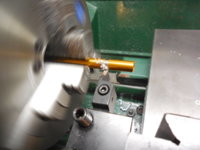
shortening some replacement tent poles. First run of a carbide insert parting tool. I suspect a somewhat dull edge on the new insert had me dropping the tool a fair amount below center to get a clean cut. Concern about a long unsupported section of thin pole inside the spindle kept my spindle speed rather low 600 rpm. Odd size aluminum foiled my attempts to chuck it in a 5c collet from the southbend tooling collection.
Chucked a ground steel dowel in the three jaw and came up within about .0003 runout.
I don't have a mill and have been noodling an adapter to put the southbend milling attachment on the grizzly crossslide. A 1/2" bigger bolt circle on the Grizzly keeps it from being simple. so far I'm thinking I'll have to start with a 6" diameter by 1" thick round bar. Which brings me to holding milling cutters in the lathe, no drawbar for the grizzly (yet), not thinking the $360 collet changer makes much sense. The spindle is MT5 and I have an mt5 to mt2 bushing. I guess I could just chuck em in the 3 jaw, but MEH
2M I see there is an Atlas 618 Yahoo group.


shortening some replacement tent poles. First run of a carbide insert parting tool. I suspect a somewhat dull edge on the new insert had me dropping the tool a fair amount below center to get a clean cut. Concern about a long unsupported section of thin pole inside the spindle kept my spindle speed rather low 600 rpm. Odd size aluminum foiled my attempts to chuck it in a 5c collet from the southbend tooling collection.
Chucked a ground steel dowel in the three jaw and came up within about .0003 runout.
I don't have a mill and have been noodling an adapter to put the southbend milling attachment on the grizzly crossslide. A 1/2" bigger bolt circle on the Grizzly keeps it from being simple. so far I'm thinking I'll have to start with a 6" diameter by 1" thick round bar. Which brings me to holding milling cutters in the lathe, no drawbar for the grizzly (yet), not thinking the $360 collet changer makes much sense. The spindle is MT5 and I have an mt5 to mt2 bushing. I guess I could just chuck em in the 3 jaw, but MEH
2M I see there is an Atlas 618 Yahoo group.
- - - Took advantage of my big horsepower last night.
View attachment 110547
shortening some replacement tent poles. First run of a carbide insert parting tool. I suspect a somewhat dull edge on the new insert had me dropping the tool a fair amount below center to get a clean cut. - - - .
Hi Gary,
Mr. Bodger's sad history of having parting tools busting off at the least excuse would have me using a hacksaw to cut those poles a tad long then facing them square and to length.
TimeMachine
SeventyEighte
A seemingly easy, small diameter tent pole will try to bend away from the cutoff tool or even try to climb on top of it if the cutoff tool is too far below center.
It is good practice to cut off as near to the jaws as possible. Get that cutoff tool "Scary close" to the whirling jaws and the outcome will be surprisingly better. Improved tool life as well .. -RT
Similar threads
- Replies
- 9
- Views
- 898
- Replies
- 24
- Views
- 7K

